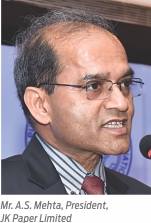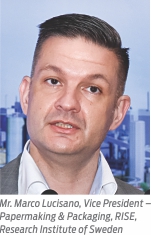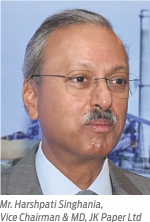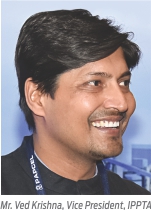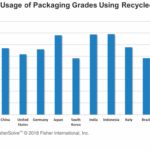In the recent IPPTA seminar, the Indian pulp and paper industry yet again affirmed its lasting commitment to constantly look for newer ways of efficient production with simultaneous focus on environmental concerns through adoption of newly emerging scientific trends.
The 54th IPPTA General Meeting and Seminar was hosted at Radisson Blu, Kaushambi in NCR Delhi with a pertinent theme ‘Innovation – For Growth & Sustainability’. The meeting and seminar on March 23-24, 2018 discussed many industry relevant issues in different panel discussions and technical sessions to a full house. There were four technical sessions and two panel discussions underscoring issues such as why constant innovation is needed for sustainability of the industry; evolution of input materials; emerging technologies in bleach plants, chemical recovery, lime kiln, etc.; improving automation through automation and digitization; environmental concerns originating from the industry; etc.
Besides, the inaugural session laid the foundation of incoming sessions quite strongly through some powerful speeches and presentations unveiling the theme and its meaning in broader context. Speakers delineated why the capital intensive industry like pulp and paper can’t forgo the technology, how significant input cost can be minimized through appropriate technological intervention, how important it is to see productivity in conjunction with environmentalism, and how important it is to balance science and technology with new emerging social trends and drivers. The keynote speaker, Mr. Marco Lucisano, Vice President – Papermaking & Packaging, Rise, Research Institute of Sweden, provide some fresh take on the term innovation and how talking about the future from science perspective connotes describing intersection of business-social trends and scientific developments. He cited the latest study called ‘A Cellulose-Based Society’, in which he gave some terrifically new ideas on how different trends and drivers are influencing the development of new materials in a circular bio-based economy.
Market, the Biggest Resource Today!
Battles for resources are not new, and the market is the biggest resource today, said Mr. A.S. Mehta, President, JK Paper Limited in his welcome address. Mr. Mehta also added that in order to win an effective share of the market, the companies need to be efficient and competitive, which is not possible without investing adequately in science and technology. “All of us are proud to be a part of the fastest growing economy and the paper industry in the world. Today, we can’t work in isolation and ought to take the world with us to make ourselves competitive,” he suggested.
According to Mr. Mehta, the capital intensive nature of the paper industry is also one of the reasons why technology plays a major role in being competitive in the market. “India is deficient in resources and can’t afford the scale and the investment in automation, which throws a challenge to all of us, especially to people from the technical background to take the industry to the newer heights and innovate day in, day out,” he added.
Mr. Mehta further said, “The theme ‘Innovation for Sustainability’ is quite apt and inspires us to be more competitive and ready for challenges by adopting the latest technological trends. Our competitiveness should be effective. In the Indian paper industry, the maximum cost is the input cost, predominantly of the raw material. We thus need to innovate ways to consume less, have cheaper raw materials, and improve our productivity, consumption practices, and other parameters. Besides, we are also an energy deficient country, which necessitates ours being more energy efficient.
“We also need to make sure we leave this mother planet in a better condition than how we received it. It is must for us to conserve all the natural resources. And, as the paper industry is labeled that we are polluting, destroying the greenery or forests, it is a challenge for us to strongly demonstrate that we are not destroying.”
Science & Business: A Balanced View
Mr. Marco Lucisano, Vice President – Papermaking & Packaging, RISE, Research Institute of Sweden was the keynote speaker at the conference and he spoke animatedly on rarely discussed futuristic perspectives of science and technology that may help the industry shape new solutions keeping in view the trends and drivers in society and business. “We are helping the companies develop new solutions to balance few perspectives like science and technology and understanding the trends and drivers in the society. We find these two parameters important. When we talk about innovations, we are talking about making new reality sort of future. It is about looking into the future, which is fascinating in itself and also challenging. If you look into the future you might want to look at the trends; you might want to talk about uncertainties and scenario,” he said.
Mr. Lucisano demonstrated vividly through a presentation how few undergoing yet path-breaking developments in science could be implemented soon in the future. “Since this is a presentation about the future, one could assume that we are trying to describe a vision for the future, or maybe a forecast. Naturally, both visions and forecast are interesting, yet neither forms the base of our way of working with foresight work. One valuable approach when talking about the future from the perspective of a science, technology and innovation company, such as RISE, is to describe interesting intersections between global trends in business and society with scientific and technical developments which are reaching the tipping point to implementation now and towards 2025 – 2030,” said he.
Talking further on the presentation, he said, “This presentation is based on our latest study ‘A Cellulose-Based Society’, a study of trends drivers influencing the development of new materials in a circular bio-based economy. Trends, uncertainties, and scenarios are three of the elements of an all round discussion about the future. This presentation focuses on trends only. Additionally, I will present a few examples of things happening around us today, which can serve as food for thoughts. Urbanization is maybe more to be regarded as a fact than as a trend. Urbanization generates a number of consequences and opportunities which have the connotation of trends.
“Yet, even as we crowd into cities and adopt urban ways of life, our need for Mother Nature’s presence in our lives does not seem to be diminishing. On the contrary, nature has been proven to have remarkable effects on our health and well-being. Our inherent emotional longing for the natural also seems to increase as we move towards a denser, more restless, fast-paced and tech-savvy society. What we need to understand is what idea of nature we urban dwellers have about nature when we long for it. This is one example from Sergels Torg, one of the most central squares in the modern part of Stockholm. As a happening a Swedish company paved the square with real green grass in early September 2016, to unleash, run barefoot, lay down on a blanket, and play games and kick ball. This is another example of “Mother Nature” taking place in an urban environment: il Bosco Verticale (the vertical forest), two residential towers in Milan, Italy, designed by Studio Boeri and opened in 2014. Recently, on March 21st, 2018, these buildings were used as an illustration of the International Day of the Forests organized by the Food and Agriculture Organization (FAO) of the United Nations with focus on Forests and Sustainable Cities.”
Mr. Lucisano also underlined how the general trend against the generation of waste got more and more evident by the day. The war against waste could very well be a trend with positive effects for the paper industry if it can provide reliable alternatives with more positive sustainability profile, he said. “Paper mill needs to consider what will happen with their product at the end of life. Shift happens; trends are about who is going to be in our business and which businesses are we as a paper industry going to be in”, he added.
Elaborating further this point, he said, “There are lots of opportunities for the paper industry to explore in various fields. One such example is of a Japanese company – a 99-year-old cloth making company in Japan makes gluten-free edible noodles out of cellulose fiber made from tree pulp. Paper mills might move towards this segment which is more profitable. Another example is tech-giant Apple’s patented white paper bag made out of 60 percent recycled paper. The company uses bags that remain both pearly white and environment-friendly. So the shift happens in this case as well.”
Mr. Lucisano also delineated on the new emerging concept of business activism. He said, “We call ‘Business Activism’ the trend exemplified by companies that start to take an increasingly active role in the pursuit of a sustainable world on both business and ethical grounds. This has a particularly large impact at a time when both politicians and consumers are perplexed and disagree on the correct ways to lead development in the right direction.
“The challenges of today are complex and even developing new technical solutions for specific problems is often outside of the possibilities of one single company or organization. The trend is clear, collaboration within a sector, among different businesses and very often even among competitors. Business activism is about companies doing things faster than they have to. So they decide to move faster than the regulatory authorities and government asks them to. To me, it is a very good approach, to begin with to always consider the companies are somewhere in the business to make money.”
Agro-Based Paper: Adaptability to Innovation
Mr. Pawan Agarwal, President, IPPTA spoke eloquently on how the industry needs to peep into the future and shape its technological practices in sync with the need of tomorrow. He said, “When we see the new innovations becoming inventions and being put to practical use, then the value is being created. The time has come when we as an industry have to really think of innovation in ideas, processes, system, technologies, and other spheres of our working domain.
“A lot of examples have been quoted by the keynote speaker Mr. Marco Lucisano. It is surprising how we don’t even know a lot of things which are happening around us. This is a phase of technological disruption. A lot of disruptions are happening and paper industry is not away from these disruptions.”
Citing the example of agro-based paper industry and how it has adapted to newer technological trends to stay relevant, Mr. Agarwal said, “I am from agro-based industry and can really relate to the examples given by Mr. Marco and can say with conviction that agro-based industry has been the best example of adaptability to innovation. We have adapted so many innovations which were not even intended for our industry in the first place. Those innovations, inventions, and ideas were developed for some sector in the paper industry and the agro-based industry have adapted to all these ideas in the past.
“It is not important to really innovate at a whole level. More important to us is our adaptability to innovation, our willingness to really put the innovative ideas around our practical views. And, if Indian paper industry can put whatever ideas floating around or innovations to its practical views in its own sphere, I think we can really take a leap forward. We can break a lot many barriers.”
Mr. Agrawal further said, “There are three fields that are having rapid innovations, viz. the chemical industry, control & automation, and environment. We have to keep in our minds that whatever new technology we put in place or the new processes we adopt, they should be in line with the requirement of the sustainable environment. This is very important. We need to think about the conservation of water. The water just has one use primarily and that is of drinking. It is not even meant for agricultural purposes when drinking water crisis lurks. We need to think on this pattern when we are consuming water in our industry and must strive constantly to reduce the enormous consumption of water. We proudly say that we have brought the water consumption from 150 cubic meters per tonne of paper to as low as 30 cubic meter per tonne in an integrated mill or 5-10 cubic meter per tonne in recycled fiber-based mill. But, we are far off from our actual target. We have to think of some dry paper manufacturing processes!”
Talking about the challenges, Mr. Agarwal added, “The Indian paper industry has got its own set of challenges. The size of the Indian paper industry is the first challenge. The second limitation is the growing localization of the market. Because of the infrastructure issues, we are not able to market our produce in the far-off areas. The third one is growing scarcity of fiber for paper and board manufacturing. We need to think of ways separately to address all these challenges and are on right track in doing so to become a globally competitive industry. We just need to put the innovative ideas into use and start our own innovations at some point of time.”
Promised Growth Spurs Technological Investments
Mr. Harshpati Singhania, Vice Chairman & Managing Director, JK Paper Ltd, the Chief Guest of the event, said that confidence of self-growth is crucial to make any kind of investment including technological. He said, “The Indian paper industry still has a great future. Despite digitization and a whole lot of disruptive trends, I think the industry has a good future. Mr. Mehta said that it is the fastest growing industry in the world. We are also one of the fastest growing economies in the world. We first need to have confidence in ourselves and believe that this industry will continue to grow and has a good future. The reason why I made this comment is unless we build an absolute confidence in our future we are not going to invest in anything. That is where our R&D and innovation comes. If I am working as a businessman for an industry which has a questionable future, I will definitely have my doubts regarding putting my money behind R&D. I will invest only when I am confident that there is a future. Moreover, we need to adapt and find solutions for what is required today.”
Mr. Singhania also stressed the need to take care of customers’ wishes while developing or producing a product. “The issue comes when we overlook the wishes of a consumer. We need to make the consumer feel comfortable and also work towards building and maintaining a sustainable environment. Afterward, we need to see how exactly we can produce in a functional and cost-effective environment. We also need to track the changes in terms of market context. And, when we are looking at the changes from a market context, we should try to look from a consumer’s perspective. Finally, we should go back a little and see what needs to be done in terms of R&D and put our efforts to find solutions accordingly. At the end of the day, we need to look at things from a consumer’s point of view,” he added.
Mr. Singhania also underlined how the Indian context is quite different than that if the world. He said, “We use the raw materials perhaps quite diverse than anywhere else. The industry also exhibits a huge disparity in scales of operations – from very small mills and machines to large integrated mills. JK being the largest in India has machines many times smaller than the global mills! The solutions need to be found keeping this context in mind, for different segments in different ways. The solutions need to be found for raw material crunch and how we can attain economies of scale.
“We need to be competitive. Import duty on paper in India is zero to the ASEAN, which covers most of our major strong paper producing neighbors. Similarly, we have a voluminous world and unless whatever we do is not comparative to the global standpoint, we would not be able to sustain our growth. We can have certain barriers but they are all temporary.”
Mr. Singhania also highlighted the glaring reality of ageing human resources in the paper industry. “I don’t see as many young people in the paper industry as I would like to see. If we look at our Indian demographics, I don’t think the Indian paper industry is representative of that. It is not a criticism, just a thought! One of the areas where the Indian industry has been lacking is its inability to fetch and retain talent. We need to pay more to attract the talent. If we pay more, we may get better output. People often think that they can’t afford to invest much in human resources. They however don’t think much about affordability when it comes to investing crores in technology. Talent pool is as indispensable as the technology. Why are we then looking at human resources as a separate bucket despite it being equally critical? Investing more in talent may lead us to grow manifold,” said Mr. Singhania.
“When you look at IoT, you look at all the kind of stuff that happens today with big data and data mining. Once we start getting into that area, we can start seeing a lot of things and trends. We would start connecting to the consumer side of the industry, wherein we would find quick solutions. It’s not an easy journey but I have faith in the Indian paper industry,” said Mr. Singhania on the use of information technology and automation in the paper industry.
Let Go of Status Quo!
On the issue of replenishing the talent pool of the industry, Mr. Ved Krishna, Vice President, IPPTA, while delivering his vote of thanks said, “It’s a fact there is a lack of young talent in the paper industry. We also had a long discussion in the executive council on this. The discussion started with the idea that we should sponsor some students. We however felt that just sponsoring some students will not raise the bar. Instead, we ended up constituting a three people committee to locate three institutes. The committee was also entrusted with responsibility of looking into possibility of collecting Rs. 2-3 Cr to upgrade the whole institute and finding a way to get talent.
“I also spoke to Mr. Marco, who was very forthcoming and assured to do something about this with us. There have to be a lot more youngsters to come in and push the boundary further. You have to find the right talent, pay them well, and they will earn for themselves.”
Mr. Krishna also said, “Innovation is something that is needed and we recognize it. I really liked the great idea of failing without fear. We have to take risks, learn to fail with grace, and stand up again to go to the next stage. It is wonderful to see what RISE is doing, and I am proud that we are associated and learning from RISE a lot.
“Fundamentally, we need to let go the status quo which keeps us bound and let go our fears to achieve that. Pawan Ji spoke nicely about it by removing mental blocks. Removing mental blocks is the key to let go the comfort zone and achieve newer heights. Our Chief Guest Mr. Singhania talked about the biggest thing, i.e. optimism. We are actually in an industry with ample opportunities, which we need to make the most of with the adoption of viable technological options.”


